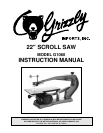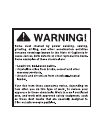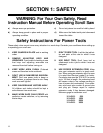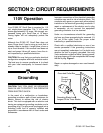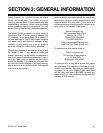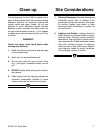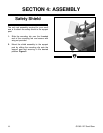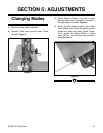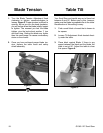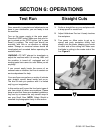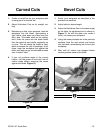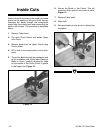
G1060 22'' Scroll Saw -3-
Additional Safety Instructions For Scroll Saws
16. REDUCE THE RISK OF UNINTENTIONAL
STARTING. Make sure switch is in off posi-
tion before plugging in.
17. USE RECOMMENDED ACCESSORIES.
Consult the owner’s manual for recommend-
ed accessories. The use of improper acces-
sories may cause risk of injury.
18. CHECK DAMAGED PARTS. Before further
use of the tool, a guard or other part that is
damaged should be carefully checked to
determine that it will operate properly and
perform its intended function-check for align-
ment of moving parts, binding of moving
parts, breakage of parts, mounting, and any
other conditions that may affect its operation.
A guard or other part that is damaged should
be properly repaired or replaced.
19. DIRECTION OF FEED. Feed work into a
blade or cutter against the direction of rota-
tion of the blade or cutter only.
20. NEVER LEAVE TOOL RUNNING UNAT-
TENDED. TURN POWER OFF. Don’t leave
tool until it comes to a complete stop.
6. Feed stock into the blade using a slow,
steady, even pressure.
7. Keep workpiece firmly against the table.
8. Wait until all motion is stopped before clear-
ing cutoff pieces away from the blade.
9. Habits are hard to break, good and bad.
Develop good habits and safety will become
second nature to you.
1. Make sure saw teeth are pointed down
toward the table.
2. Maintain proper blade tension.
3. When making adjustments, keep power off
and the power cord unplugged.
4. To test adjustments, rotate the Rocker Arm
slowly by hand. Never assume an adjust-
ment is correct and then turn the power on.
5. Adjust Hold-down Foot so it barely touches
your workpiece.
10. WEAR PROPER APPAREL Do not wear
loose clothing, gloves, neckties, rings,
bracelets, or other jewelry which may get
caught in moving parts. Non-slip footwear is
recommended. Wear protective hair covering
to contain long hair.
11. ALWAYS USE SAFETY GLASSES. Also
use face or dust mask if cutting operation is
dusty. Everyday eyeglasses only have
impact resistant lenses, they are NOT safety
glasses.
12. SECURE WORK. Use clamps or a vise to
hold work when practical. It’s safer than
using your hand and frees both hands to
operate tool.
13. DON’T OVERREACH. Keep proper footing
and balance at all times.
14. MAINTAIN TOOLS WITH CARE. Keep tools
sharp and clean for best and safest perfor-
mance. Follow instructions for lubricating and
changing accessories.
15. DISCONNECT TOOLS before servicing and
changing accessories, such as blades, bits,
cutters, and the like.



